122 mm howitzer 2A18 (D-30)
The 122-mm howitzer D-30 (GRAU index 2A18) is a Soviet howitzer that first entered service in 1960. It is a robust piece that focuses on the essential features of a towed field gun suitable for all conditions. The D-30 has a maximum range of 15.4 kilometers, or over 21 km using RAP ammunition.
| 122 mm howitzer 2A18 (D-30) | |
|---|---|
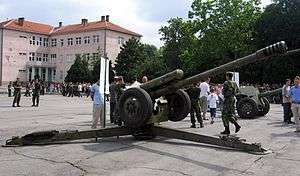 D-30 Howitzer of the Serbian army | |
| Type | Howitzer |
| Place of origin | Soviet Union |
| Service history | |
| In service | 1960–present |
| Used by | Soviet Union and allies as well as nonaligned and post-Soviet states. |
| Wars | Lebanese Civil War Western Sahara War[1] Uganda–Tanzania War[2] Soviet–Afghan War[3] Iran–Iraq War Gulf War Somali Civil War Yugoslav War Second Congo War[4] Boko Haram insurgency Syrian Civil War[5] Iraqi Civil War (2014–2017)[6] War in Donbass[7] Yemeni Civil War (2015–present)[8][9] many regional conflicts. |
| Production history | |
| Designer | F.F. Petrov |
| Designed | 1950s |
| Manufacturer | PJSC «Plant № 9» |
| Produced | 1960–present |
| Variants | See variants |
| Specifications | |
| Mass | Combat: 3,210 kg (7,080 lb) |
| Length | Transport: 5.4 m (17 ft 9 in) |
| Barrel length | 4.66 m (15 ft 3 in) 38 calibres[10] |
| Width | Transport: 1.9 m (6 ft 3 in) |
| Height | Transport: 1.6 m (5 ft 3 in) |
| Crew | 1+7 |
| Shell | 122 x 447mm .R Separate loading charge and projectile[10] |
| Caliber | 122 mm (4.8 in) |
| Breech | Semi-automatic vertical sliding-wedge[10] |
| Recoil | Hydro-pneumatic |
| Carriage | tripod |
| Elevation | −7° to 70° |
| Traverse | 360° |
| Rate of fire | Maximum: 10–12 rpm Sustained: 5–6 rpm |
| Effective firing range | 15.4 km (9.6 mi) 21.9 km (13.6 mi) (with rocket-assisted projectile) |
With its striking three-leg mounting, the D-30 can be rapidly traversed through 360 degrees. Although no longer manufactured in the nations of the former Soviet Union, the D-30 is still manufactured internationally and is in service in more than 60 countries' armed forces.
The barrel assembly of the 2A18 gun is used by the 2S1 self-propelled howitzer. There are also Egyptian, Chinese, Serbian and Syrian self-propelled variants and conversions. The Syrian conversion utilizes the hull of a T-34 tank.
History
The 122 mm (originally 48 lines) calibre was adopted by Russia in the early 20th century, becoming very important to Soviet artillery during the Second World War. Development of the D-30 began in the 1950s, as a replacement for the M-30 howitzer, widely used in divisional and regimental artilleries. The D-30 also replaced the remaining 76 mm M1942 guns in motor rifle regiments.
Military requirements that led to the D-30 can only be deduced. Its role supporting tank and motor rifle regiments, and Soviet doctrine from the Great Patriotic War, suggest that while indirect fire was the primary role, direct fire anti-tank was very important. The latter is evidenced by the very effective HEAT shell, the low silhouette of the piece, its wide and rapid top-traverse and its shield.
The D-30 was designed by the well established design bureau at Artillery Plant No 9 in Sverdlovsk (now Ekaterinburg), at the time led by the eminent artillery designer Fëdor Fëdorovich Petrov (1902–1978). This team was responsible for designing the earlier M-30, the post-war 152 mm D-20 gun-howitzer, and other guns.

Soviet divisional artillery was assigned to manoeuvre regiments (in regimental artillery groups – RAGs) and as divisional troops (in divisional artillery groups – DAGs). A RAG was normally three batteries, each of six pieces, to each motor rifle and tank regiment. DAGs were mostly equipped with 152 mm pieces, but the DAG of a motor rifle division included a D-30 battalion. The role of an RAG was a normal field artillery role to support manoeuvre forces with indirect, semi direct and direct fire.
The D-30 entered Soviet service in 1963 and is sometimes referred to as the M1963. In 1967, widespread introduction of self-propelled guns was authorised and the D-30's barrel and ammunition was used for the new 2S1. When the 2S1 entered service, it was usually assigned to tank regiments and motor rifle regiments equipped with BMP infantry fighting vehicles (IFVs). D-30s were retained in motor rifle regiments equipped with BTR APCs.
The D-30 has been widely exported and used in wars around the world, notably in the Middle East, and particularly in the Iran–Iraq War, a long-lasting war of attrition similar to World War I.
The gun remains a mainstay of artillery forces in developing countries and is deployed in the war in Afghanistan. Soldiers from several western armies have been trained on the D-30 by various user nations in order to be able to train Afghan soldiers on it.
In 2017, the Algerian military displayed a locally developed variant mounted on a Mercedes-Benz Zetros truck. It includes four stabilization legs to absorb firing impacts.[11]
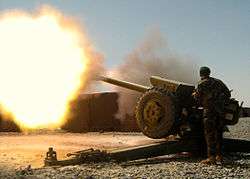
Description
.jpg)
Distinctive features of the D-30 include its low mobile mounting and above-barrel recoil system. The three-legged mobile mount is unusual for field artillery, with stabilizers that are clamped together for towing and deployed when in action. A large tow linkage is fixed to the muzzle; in transport the barrel serves as a trail. Similar mounts were a feature of several 76-mm pre-war (1931–1935) universal (both field and anti-aircraft) guns designed by Leningrad's Kirov Plant (L-1, L-2 and L-3). Other examples were the 1939 French 47SA39 APX, and 1943 German 105-mm light field howitzers designs by Skoda and Krupp; neither entered service. The Bofors 105 mm L28 Light Field Howitzer 4140[12] was similarly arranged with four legs and did enter Swedish service. The 1930s-designed British 2-pdr. anti-tank gun was another piece featuring a three-legged mounting.
Compared to the M-30, the new howitzer had a significantly longer 35 calibre gun barrel, just short of being a gun-howitzer by Soviet definition. Like other guns of the period, it had a high efficiency muzzle brake; this improved muzzle velocity by 175 m/s to a total of 650 m/s for HE, and raised maximum range by 3,500 m beyond the similar M-30. Maximum range was 2 km better than the 76 mm M1942 at 15.3 km. Weight increased by 650 kg over the M-30, to 3,150 kg; the D-30 is over twice the weight of the 76mm M1942. Accuracy improved, with mean error at about 10 km dropping from 35 m with the M-30 to just 21 m.
Effective stabilisation length is a fundamental aspect of a gun mount, and legs 120° apart need to be longer than those with a smaller angle. The D-30's design minimises this problem in several ways. Trunnions are close to the ground, as a result of placing the recoil system and cradle above the barrel. The trunnions are also at the very rear of the breech; this maximises the recoil space when firing at higher elevation angles. Their rearward position also pushes the recoiling element forward on the mount, maximizing relative rearward span of the stabilizers and so stability during recoil. Additionally there is a very efficient muzzle brake, which absorbs about half the recoil. There is no mechanism to reduce recoil length as the angle of elevation increases.
Some of the design decisions have a price. The muzzle brake produces about twice the overpressure in the area around the gun that is acceptable to Western armies, and is the reason it is often seen being fired with a long lanyard, which reduces rate of fire. Furthermore, the maximum elevation angle is restricted to 18° (early versions) or 22° (later versions) when the breech is over a trail leg. This is enforced by a mechanical cam that prevents the piece firing for about 60% of the total top traverse, and limits range to about 12 km, with full maximum range only possible in the central arc of about 48° between each pair of legs. The extreme rearward location of the trunnions means the elevating mass is unbalanced, requiring a strong balancing mechanism to enable manual elevation. To do this, the D-30 uses compression balancing gears.
A central jack is powered by hand-operated hydraulics. This jack is lowered while the wheels are raised to permit two of the stabiliser legs to be swung 120° rearwards. The mounting is then lowered and the ends of the legs spiked to the ground. This mounting provides for quick traversing to fire in any direction.
The pair of large tires are suspended on a single trailing arm; maximum towing speed is 60 km/h on the road. As was normal in Soviet designs, the tyres were filled with foam. Initially, the D-30 had no brakes and no seat for the layer—non-essential luxuries.
A sliding block breech was adopted instead of the M-30's pre-1914 screw pattern, giving a slight increase in the rate of fire. It is a semi-automatic vertical sliding block breech, with a tied jaw; the block moves down to open and opens automatically ejecting the empty cartridge case as the recuperator forces the gun tube back into battery after a round is fired. The design is closely related to those of breeches on other Soviet post–World War II guns and howitzers.
The non-reciprocating sights are standard Soviet pattern, designed for one-man laying. Included are a direct fire anti-tank telescope, a panoramic periscopic indirect-fire sight (dial sight) in a reciprocating mounting, an angle of sight scale, and a range drum for each charge engraved with the range (distance) scale. The elevation leveling bubble is mounted on the dial sight mount. The range drum enables the standard Soviet technique of semi-direct fire when the piece is laid visually on the target and the range set on the range drum.
Soviet 122 mm howitzers used different ammunition to 122 mm guns, although there was some compatibility. In the case of ammunition for the D-30, the standard 122 mm howitzer shell weight of 21.8 kg was retained, with a metal cartridge case holding variable propelling charges. Cartridge and shell are loaded separately; this means that the shells have to be hand-rammed by a man to the right of the breech with a ramming rod. The D-30 could fire the older M-30 ammunition; however, new shells were also introduced, eventually including a rocket assisted projectile with a range of 21.9 km. The M-30's range of propelling charges, comprising base and eight increments, was replaced by a new set comprising base and four increments; single base propellant was retained. A more effective High Explosive (HE) shell was developed, as well as smoke, illumination and chemical filled projectiles.
In keeping with Soviet doctrine, the anti-tank role is important; there is a HEAT shell capable of penetrating 460 mm of steel armour plate.
The maximum rate of fire of the D-30 is 6–8 rounds per minute, and about 75 rounds per hour. There is disagreement as to whether this maximum rate of fire is achievable for indirect fire. Based on reloading speeds of similar guns using separate charges, solo re-laying, and given a stable emplacement, semi-automatic breech and no long lanyard, (examples are the 25-pdr. and 105mm L118), and assuming concurrent lay adjustment during reloads, then it probably is when in the hands of a competent detachment. However, 5-6 rounds per minute may be more realistic with a poorly trained gun crew.
The D-30 is noted for simplicity of maintenance by its users; reputedly there are no special tools, all jobs can be done with a wrench and large hammer. However, like any other gun, routine maintenance is essential, and western troops in Afghanistan have reported Afghan manned D-30s having problems with shells sticking in the barrel due to lack of cleaning.
Self-propelled versions
- 2S1 Gvozdika was developed on basis of MT-LB tracked vehicles that were often employed by Soviet forces for towing instead of trucks. Combining the gun D-30 with the chassis of the MT-LB, the 2S1 Gvozdika was made. This was the first Soviet enclosed turret self-propelled artillery gun, going into service in the early 1970s. The 2S1 is very light and mobile, and amphibious without preparation. Good mobility and the quick reaction abilities of the 2S1 enhance the flexibility of the D-30, reducing its vulnerability in maneuver battles.
- Sora 122mm Most modern self-propelled version of the D-30J with automatic loader, inertial navigation system (INS) and fire control system, mounted on a modified FAP 2026 chassis designed by Military Technical Institute Belgrade.
- SH-2 Chinese wheeled version developed by Norinco. It has a modern fire control system and howitzer is elevated by electric motors.[13]
- PLZ-07 Chinese version of tracked D-30 122mm. It has NBC protection system, night/day driving vision, firing control system.
- Semser developed by Israel's Soltam under contract to the Kazakhstani Ministry of Defense, manufactured by local Kazakh companies. Has an integrated automated command and control system, provided by Soltam and Elbit. Is based on KamAZ-6350 8x8 chassis.[14]
There is more self-propelled versions developed by other countries by mounting D-30 on some tracked or wheeled vehicles at disposal of their armed forces. Most of them do not have any complex fire control system and are manually loaded and elevated. Cuba, Sudan, Laos, Syria and Egypt have produced such simplified variants. [15][16][17][18]

Post 1973, Syrian and Egyptian armed forces fielded D-30 guns fitted to the hulls of obsolete T-34 tanks, similar to Israeli conversions of Sherman hulls. This rather crude modification improves the speed of divisional artillery, allowing for the ability to match speed with front-line mechanized forces. A major drawback is the lack of protection for the gunners.
Variants
- 2A18 or D-30 – basic model, as described.
- 2A18M or D-30M – new double baffle muzzle brake, square central base plate, towing lunette assembly.
- 2A18M-1 or D-30M-1 – with semi-automatic loader. Prototype.
- D-30A – modified recoil system, new muzzle brake.
- 2S1 Gvozdika self-propelled version.
- Type 85 or D-30-2 Chinese self-propelled version of the D-30.
- D-30-3 – Chinese upgrade of the Type 56 85 mm field gun with 122 mm weapon.
- Type 86, variously, Type 83, Type 96 – Chinese licence-production or derivative of the D-30.
- D30 RH M-94 – Croatian built version, new muzzle brake, redesigned trail, improved hydraulic brake.
- D 30-M – Egyptian licence version of the D-30.
- HM 40 Iranian version.
- Shafie D-30I or HM-40 – Iranian version.
- D-30J – Yugoslav version of the D-30 - heavily modified version based on license designed by Military Technical Institute Belgrade
- Saddam – Iraqi designation of Yugoslavia D-30J produced on license bought from Yugoslavia.
- D-30JA1 – Improved Serbian version - further development of D-30J.
- Sora 122mm - Self-propelled version of D-30J
- M-91 "Mona" – Yugoslav variant with the 100 mm ordnance of the MT-12. Prototype only.
- Khalifa-1 – Sudanese licensed version of the D-30.
Emplacement procedure
A location chosen for emplacement of the D-30 should be as level as reasonably possible. Firstly, the carriage is raised via an internal hydraulic jack located under the cradle of the gun. Once the gun is at the required height, the wheels are raised via the wheel lifting lever; this allows the two split stabilizer legs to be separated from the mono stabiliser leg and brought rearward into firing configuration.
The legs are then locked in place with locking pins. The carriage is lowered via the hydraulic jack so that the legs touch the ground; integral stakes are then hammered into the ground. At this point, the gun is ready for direct fire using the OP4 direct fire sight, or can be orientated and have its position fixed via the aiming circles for subsequent indirect fire using the Pantel sight.
Ammunition
The D-30 fires separate loading projectiles, with variable charges:
| Available Projectiles | |||||||
| Designation | Type | Fuze | Weight | Explosive filler/payload | Muzzle Velocity, (max. propellant charge) | Armor Penetration | Notes |
| OF-462 | FRAG-HE | RGM-2,D-1,D1U V-90,AR-5 |
21.76 kg | 3.675 kg of TNT | 690 m/s | n/a | |
| 3OF56 | FRAG-HE | RGM-2,D-1,D1U V-90,AR-5 |
21.76 | 4.05 kg of A-IX-2 | 690 m/s | n/a | Improved HE-FRAG. |
| SH-1 | AP Flechete | RGM-2,D-1,D1U V-90,AR-5 |
? | ? | ? | n/a | ? |
| BK-6M | HEAT-FS | GPV-2 | 17.47 kg | 1.6 kg of A-X-1 | 740 m/s | 460 mm to 580 mm | |
| BK-13 | HEAT-FS-T | V-15 | 21.4 kg | 2.1 kg | ? | ? | |
| S-463 | Illumination | T-7 | 22.4 kg | 1 kg flare | 690 m/s | n/a | Illumination time ≥ 25 s |
| D-462 | Smoke | KTM-2 | 22.3 kg | 3.6 kg of WP | 690 m/s | n/a | |
| 3OF69M | Laser guided | ? | 28 kg | 5.5 kg HE-FRAG | ? | ? | |
| ? | ICM | Ms-1 | 22.5 kg | 18 M-42 bomblets or 15 M-42D bomblets |
683 m/s | M42 – 70 mm M42D – 110 mm |
Egyptian made |
| M335 (CL 3153) | ICM | ? | 22.5 kg | 24 M85 bomblets | 698 m/s | 105 mm | Israeli round |
| TF ER BB ХМ09 | FRAG-HE | ? | n/a | Range 21.500m | |||
| TF ER BT ХМ08 | FRAG-HE | n/a | Range 18.500m produced by Sloboda Čačak | ||||
| Norinco ERFB/HB | FRAG-HE | ? | 21.76 kg | ? | 725 m/s | n/a | Chinese produced |
| Norinco ERFB/BB | FRAG-HE | ? | 22.25 kg | ? | 730 m/s | n/a | Chinese produced |
| Norinco Cargo | ICM | ? | 21.76 kg | 30 Type 81 bomblets | 682 m/s | 80 mm | Chinese produced |
| Norinco HE-I | HE-I | ? | 21.76 kg | ? | 690 m/s | n/a | Chinese produced |
| Norinco Smoke | Smoke | ? | 22.15 kg | 3.2 kg of WP | 690 m/s | n/a | Chinese produced, produces smoke for more than 70 seconds. |
| Norinco Illumination | Illumination | ? | 21.3 kg | 1.09 kg flare | 683 m/s | n/a | Chinese produced, 600,000 candela flare, burns for 50 seconds. |
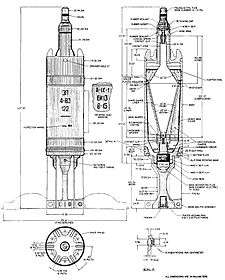 BK-13 HEAT shell.
BK-13 HEAT shell.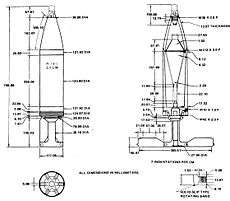 BK-6M HEAT shell.
BK-6M HEAT shell. OF-462 HE shell.
OF-462 HE shell.
Operators

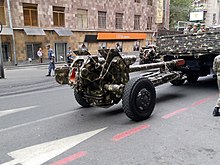
Current operators









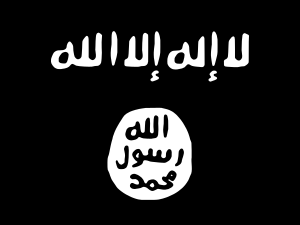




























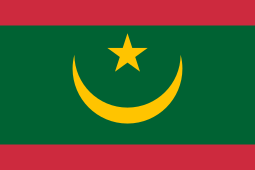











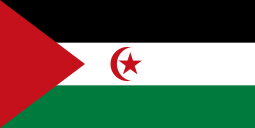















Former operators






.svg.png)
References
- Francesco Palmas (2012). "Il contenzioso del sahara occidentale fra passato e presente" (PDF). Informazioni della Difesa (in Italian). No. 4. pp. 50–59. Archived (PDF) from the original on 2018-06-12. Retrieved 2018-06-12.
- Cooper, Tom; Fontanellaz, Adrien (October 2016). "La guerre du Kagera". Batailles et Blindés (in French). No. 75. Caraktère. pp. 72–81. ISSN 1765-0828.
- Zaloga, Steven; Luczak, Wojciech; Beldam, Barry (1992). Armor of the Afghanistan War. Armor 2009. Concord Publications. p. 7. ISBN 978-9623619097.
- Cooper, Tom (2013). Great Lakes Conflagration: Second Congo War, 1998 2003. UK: Helion & Company Limited. p. 49. ISBN 978-1-920143-84-8.
- "[Syria] Highway M-20 - Deir ez-Zor. Hunting for "snakes" - Шоссе M-20 - Дейр ез-Зор. Охота на "змей"". YouTube. Archived from the original on 30 December 2017. Retrieved 13 January 2018.
- PressTV News Videos (26 August 2017). "The Debate - Dying days of Daesh". Archived from the original on 26 May 2018. Retrieved 13 January 2018 – via YouTube.
- "05/10/14 Fights for Donetsk airport. Exclusive interview with Givi". Archived from the original on 2014-10-11. Retrieved 2019-07-01.
- شبكة المجد (8 September 2014). "#السلسلة_الوثائقية_الحوثيون - الجزء الأول". Archived from the original on 14 June 2016. Retrieved 13 January 2018 – via YouTube.
- "YouTube". www.youtube.com. Archived from the original on 17 August 2017. Retrieved 13 January 2018.
- Foss, Christopher (1977). Jane's Pocket Book of Towed Artillery. New York: Collier. p. 93. ISBN 0020806000. OCLC 911907988.
- Binnie, Jeremy (4 July 2017). "Algeria displays locally developed self-propelled artillery". IHS Jane's 360. Archived from the original on 6 July 2017. Retrieved 6 July 2017.
- http://bastion-karpenko.narod.ru/Univer_KZ.pdf Archived 2015-01-22 at the Wayback Machine (in Russian)
- "SH2 wheeled self-propelled howitzer 122mm technical data sheet specifications description pictures | China artillery vehicles and weapon systems UK | Chinese China army military equipment armoured UK". Armyrecognition.com. 2011-11-28. Archived from the original on 2016-12-09. Retrieved 2017-02-27.
- ARG. "Semser 122-mm Self-Propelled Howitzer - Military-Today.com". www.military-today.com. Archived from the original on 14 January 2018. Retrieved 13 January 2018.
- Hoàng Lê (2013-11-27). "Xem quân đội Cuba tập trận Bastion 2013 | Quân đội". Kienthuc.net.vn. Archived from the original on 2016-11-22. Retrieved 2017-02-27.
- "Khalifa GHY02 D-30 122mm 6x6 wheeled self-propelled howitzer technical data sheet specifications | Sudan Sudanese army artillery vehicles systems UK | Sudan Sudanese army military equipment vehicles UK". Armyrecognition.com. 2013-03-15. Archived from the original on 2017-03-11. Retrieved 2017-02-27.
- "Archived copy". Archived from the original on 2019-01-03. Retrieved 2019-01-02.CS1 maint: archived copy as title (link)
- "Future Artillery Systems: 2016 Market Report" (PDF). Tidworth: Defence IQ. 2016. Archived from the original (PDF) on 22 January 2018. Retrieved 21 January 2017.
- The Military Balance 2016, p. 181.
- The Military Balance 2016, p. 492.
- "Appraisal of PLA Artillery Modernisation". Centre for Land Warfare Study.
- The Military Balance 2016, p. 83.
- The Military Balance 2016, p. 393.
- The Military Balance 2016, p. 324.
- The Military Balance 2016, p. 445.
- "Trade Registers". armstrade.sipri.org. Archived from the original on 5 August 2009. Retrieved 13 January 2018.
- Finnish Defence Forces. "Republic of Finland's 2018 AEMI (Annual Exchange of Military Information) report". Retrieved 2018-08-10.
- The Military Balance 2016, p. 93.
- The Military Balance 2016, p. 450.
- Iraqi army equipment 1930-2017. 2. p. 119.
- Military & Defense. "Peshmerga Military Equipment". Business Insider. Archived from the original on 2017-08-06. Retrieved 2017-02-27.
- The Military Balance 2016, p. 491.
- The Military Balance 2016, p. 334.
- Gibson, Neil; Fediushko, Dmitry (22 January 2019). "Laotian military parades Russian- and Chinese-made equipment". Jane's 360. London, Moscow. Archived from the original on 2019-01-23. Retrieved 24 January 2019.
- The Military Balance 2016, p. 340.
- The Military Balance 2016, p. 342.
- The Military Balance 2016, p. 120.
- The Military Balance 2016, p. 280.
- The Military Balance 2016, pp. 190-201.
- "Morocco" (PDF). Tel-Aviv: Institute For National Security Studies. 1 March 2016. Archived from the original (PDF) on 26 June 2017. Retrieved 25 June 2016.
- "Sudan - Global trade, local impact: Arms Transfers to all Sides in the Civil War in Sudan" (PDF). Human Rights Watch Report. 10 (4): 24. August 1998.
- The Military Balance 2016, p. 471.
- The Military Balance 2016, p. 137.
- The Military Balance 2016, p. 203.
- "Zimbabwe Defence Forces". defenceweb.co.za. 13 October 2014. Archived from the original on 15 November 2017. Retrieved 2015-06-28.CS1 maint: BOT: original-url status unknown (link)
- Krott, Rob (October 2003). "Macedonia's Weaponry: A New Nation Re-Arms and Fights". Small Arms Review. Vol. 7 no. 1. Archived from the original on 2019-03-30. Retrieved 2019-03-30.
External links
Sources
- Chris Bellamy, Red God of War: Soviet Artillery and Rocket Forces, Brassey's Defence Publishers, 1986, ISBN 0-08-031200-4
- International Institute for Strategic Studies (February 2016). The Military Balance 2016. 116. Routlegde. ISBN 9781857438352.